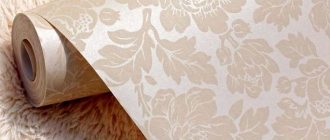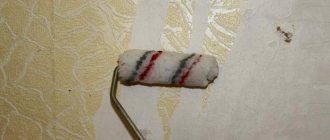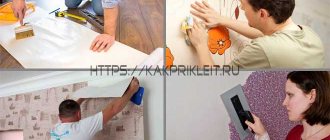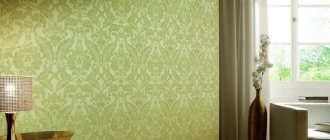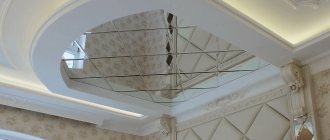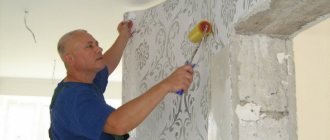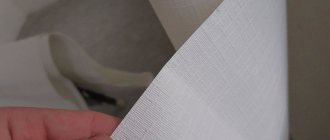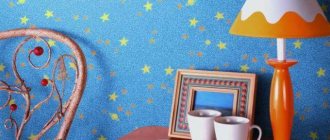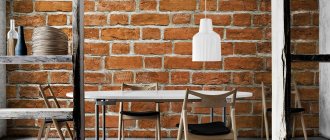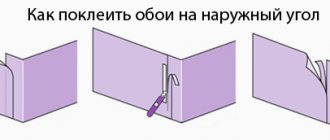Non-woven wallpaper is a huge success when choosing a decorative covering for residential and office premises. Most people who once bought them refuse other types, and recommend non-woven wallpaper to friends and acquaintances.
Many housewives cover their walls with this type, as they are easy to glue and can subsequently be washed. Let's try to find out why this type of decorative coating is so popular in our article. Let's consider all the characteristics, pros and cons of non-woven wallpaper.
Non-woven fabric can be used as an independent component of which the wallpaper is made, or as an additional component, as a base for coating. Seventy percent of non-woven fabric consists of cellulose, which makes the material look like paper, and thirty percent consists of different binders, thanks to which the wallpaper looks like fabric.
By the way, this type of wallpaper first appeared in Germany. Interlining was originally used in the sewing world, but clever Germans took it a step further and began using it as a base for a durable and strong coating.
The wallpaper is entirely made of non-woven fabric. What does it mean?
Usually, from the name of the wallpaper you can find out what kind of material is used in its production. For example, paper wallpaper requires paper, cork wallpaper requires cork. By analogy, wallpaper made from non-woven material should be called non-woven wallpaper, but it turns out that non-woven wallpaper often includes not only wallpaper made exclusively from non-woven material, but also wallpaper with vinyl or other coating on a non-woven base. The two finishing materials are very similar in appearance, but the consumer properties of non-woven vinyl wallpaper and real non-woven wallpaper are significantly different.
The consumer who has made his choice and intends to purchase real non-woven wallpaper should be careful when purchasing it. It happens that even in large chain stores selling building materials, on the price tags both non-woven wallpaper and non-woven wallpaper are designated under the single name “non-woven wallpaper”. Therefore, before you buy the coatings you like, you should contact your sales consultant, and also carefully study the information from the manufacturer on the insert in the product roll.
Colors and designs
Looking at the photo of non-woven wallpaper in the interior, one cannot help but be amazed at the variety of patterns and colors offered.
Large design elements, such as roses and monograms, are suitable for oriental-style rooms. Wallpaper imitating brick or stone will emphasize the originality of the apartment's interior.
A part of the wall covered with striped wallpaper will harmoniously combine with the plain background of the other walls; and lovers of bright details will be pleased with the wallpaper options with photo printing.
Composition and classification of non-woven wallpaper
Non-woven wallpaper is a non-woven dense fabric formed into a roll. They are produced by pressing several layers of cellulose fibers, intertwined in a certain way and impregnated with a polymer binder. Sometimes other materials are added to the composition: paper, textile threads, polyester fibers. Thanks to the use of cellulose, the wall covering is durable and elastic, as well as “breathable”, like paper. Essentially, this is an improved type of paper wallpaper.
Non-woven wallpaper is classified according to the following parameters:
— according to surface structure: embossed, smooth and embossed (with textured patterns);
— according to moisture resistance: ordinary, waterproof and washable;
- according to the density of the fabric: single-layer light and multi-layer heavy;
— according to the presence of a pattern: single-color natural white, gray or yellowish (for painting), with a factory-made monochromatic color, with a printed pattern.
Sizes of non-woven wallpaper rolls:
— width 53 cm, length 10 m 05 cm;
— width 1 m 06 cm, length 10 m 05 cm;
— width 53 cm, length 15 m (for painting);
— width 70 cm, length 25 m;
— width 1 m 06 cm, length 25 m (for painting).
Expensive two-layer non-woven wallpaper with a pattern consists of a base and a cover. The base is a layer that is attached to the wall or ceiling with glue. A coating is applied to it - an outer decorative layer. It is important to remember that real non-woven wallpaper is the kind of wallpaper in which both the base and the coating are made of non-woven material, that is, a non-woven coating on a non-woven base! This kind of wallpaper appeared on the construction market not so long ago.
Non-woven wallpaper is available not only with a printed pattern, but also for painting. These are single-layer and two-layer coatings in light colors: white, yellowish, cream. Water-based acrylic and latex paints are suitable for painting them, depending on the choice of which the surface may acquire additional properties. In particular, latex-coated wallpapers are easy to clean. The use of paints with a non-aqueous composition reduces the breathability of the coating.
Non-woven wall coverings are ideal for bedrooms and children's rooms. The finishing material is made from environmentally friendly materials and allows the walls to “breathe” (has air permeability). Due to the variety of patterns, colors and textures, such coverings look great in living rooms. It is not recommended to cover the walls of hallways, kitchens, and bathrooms with non-woven wallpaper. They won't last long in these rooms.
Properties of non-woven fabric
Undyed non-woven interlining is a non-woven paper-like material of a yellowish or white color. Due to chemical cross-linking and modification of fibers during the formation of the material, interlining has tensile strength, fire resistance and abrasion resistance. Depending on the chemical modifications of the fibers that form the interlining matrix, it can be non-wettable, water-wettable or water-soluble. Water-insoluble non-woven fabric does not lose shape when in contact with water and does not shrink when dried. The material almost does not wrinkle and easily tolerates non-aqueous paints, this allows you to obtain non-woven fabric of all colors.
Eco-friendly, breathable and vapor permeable
The surface of walls covered with non-woven wallpaper does not emit unpleasant odors, harmful substances that cause allergies and have other negative effects on the health of people in the room.
The finishing material, made exclusively from non-woven fabric, ensures air circulation in the room (“breathes”). The air does not “stagnate”, which means a favorable microclimate is ensured without an additional ventilation system.
The use of a special method of gluing cellulose fibers ensures good vapor permeability of the coating. During operation, moisture does not accumulate under it and conditions for the formation of mold are not created.
Two-layer wallpaper, which is made only from non-woven fabric (the top and main layers are non-woven), as well as single-layer and double-layer non-woven wallpaper for painting, are excellent for gluing in bedrooms and children's rooms. The finishing material is made from environmentally friendly materials, has good breathability, creates comfort and an excellent microclimate for residents.
It is important to distinguish between real non-woven wallpaper and non-woven vinyl wallpaper! The presence of a top vinyl layer prevents air exchange and does not eliminate the release of formaldehyde.
Choosing wallpaper depending on the interior style
For interiors decorated in Provence and country style, experts advise choosing wallpaper with birds. This design helps create a summer garden atmosphere in the room.
Fans of the classics should take a closer look at textile wallpapers with a top made of natural fabric or canvases made using thread-to-thread technology.
Ease and simplicity of operation, versatility
The density and elasticity of non-woven fabric make it easy to work with wallpaper. It is also important that when gluing, only the wall is treated with the adhesive solution, and no glue is applied to the wallpaper. Non-woven wallpaper adheres perfectly to any surface: plastered, plasterboard, plaster, concrete, cardboard, chipboard, wood, and can be easily removed during dismantling.
Rolls are often one meter wide, which is quite convenient when gluing. Buying non-woven wallpaper of this width means saving time for applying stripes and preparing a place for this process, as well as reducing the number of joints between the sheets.
After contact with glue, non-woven coatings do not deform and do not shrink when drying. Therefore, the joints do not diverge and are invisible on the surface. The finish hides small cracks and unevenness, which allows you to avoid wasting time, money and effort on flawless alignment of walls and ceilings.
Specifics of working with glue
It is worth noting that non-woven material is much heavier than paper, as a result of which working with it requires the use of special adhesives. All major manufacturers produce them.
By the way, gluing two-layer non-woven wallpaper will significantly simplify future repairs.
After removing the decorative layer, the bottom one will become the basis for a new finish. It just needs to be primed.
Features of non-woven wall coverings
In some cases, decorating premises with non-woven wallpaper does not suit homeowners. Therefore, when choosing wall coverings, you must take into account several factors.
• Cellulose fibers are the basis of non-woven wallpaper. Due to their hygroscopicity, the finishing material is capable of accumulating moisture. Consequently, it is recommended to glue non-woven wall coverings (in which both the top and main layers are non-woven) only in dry rooms.
• Non-woven wallpaper with a textured surface accumulates a lot of dust, which requires frequent cleaning. Dirty stains are not easy to remove, because the material can only withstand dry cleaning. This type of finishing is not recommended for rooms where people prone to allergies may stay for a long time.
• Low resistance to mechanical damage - a quality inherent in non-woven wall coverings. Touching with sharp or hard objects leaves marks on the wall. The relief finish is easy to damage; it is not resistant to mechanical stress or abrasion.
• Single-layer wallpaper for painting is distinguished by the fact that it is translucent. The working surface must be brought to a uniform color before gluing. If glue stains, old paint, and inscriptions on drywall are not removed from the wall, then all this will certainly appear through the single-layer non-woven material.
• High-quality dense two-layer non-woven wallpaper is more expensive than many types of wall coverings. Wallpapering for painting will incur additional costs: purchasing paint and tools, paying for these works.
How to glue non-woven wallpaper
Non-woven wallpaper is a universal wallpaper whose range of uses is enormous. They are pasted over in production areas and in residential premises. They perfectly hide the imperfections of walls, leveling their surface with minimal preparation. They can be glued to drywall, concrete, all types of plaster and other substrates. Before gluing non-woven wallpaper, you need to select an adhesive. It should be borne in mind that for most other types of wallpaper you can use universal glue, while this one requires a special one. It is applied directly to the wall surface with a roller, which makes the process easier.
Wallpaper must be glued without overlap and so that the joints are even. Using a roller, you need to remove air bubbles that form between the wall and the material. Gluing non-woven wallpaper differs from the technology of gluing paper and vinyl in that the glue is applied directly to the surface, and not to the wallpaper. This saves glue and reduces the amount of work.
Popular manufacturers of real non-woven wallpaper
In Russia, the production of modern printed non-woven wallpaper (not vinyl on a non-woven basis) is established in the Nizhny Novgorod region at the factories of Loymina LLC. The enterprises use modern equipment systems that allow them to produce wallpaper that is not inferior in consumer properties to products from foreign companies. Mostly imported materials are used in production: non-woven fabric, safe pigments for printing ink. Wall coverings are produced in accordance with Russian and international sanitary requirements and quality standards.
On the market of construction and finishing materials, the products of the Russian manufacturer are represented by the Loymina and Milassa brands. Their collections are different:
- composition of environmentally friendly materials;
— modern design of printing, textures, relief patterns;
- a rich palette of shades, interesting ornaments;
— reinforcing properties;
- meter roll width.
The elite brand Loymina includes more than 30 collections from the category of expensive luxury wallpaper, made in various styles. Decorative wall coverings follow fashion trends, embodying both modern and classic motifs. Loymina wallpapers have an original, expensive and very attractive look.
Wallpaper collections of the Milassa brand were created taking into account marketing research, consumer wishes, and belong to the middle price segment. The products are made from high-quality and environmentally friendly raw materials (cellulose and textile fibers) using water-based paints. Milassa wallpaper is included in the category of washable wallpaper, suitable for hanging in any room.
Prices for Milassa wallpaper are lower than for wallpaper from the Loymina brand due to cheaper production: the use of new technologies for producing paints, reducing the density of non-woven fabric, and launching high-speed printing equipment. The manufacturer also offers Loymina Glue, designed specifically for non-woven wallpaper.
Many Russian companies have launched the production of non-woven wallpaper for painting, often in collaboration with well-known foreign manufacturers. The finishing material is produced in compliance with environmental standards, from imported non-woven fabric, with a wide range of textures and patterns, with different price ranges. Wallpaper from factories is of good quality. The company cooperates with leading German manufacturers, including even the famous AS Creation.
Most of the imported non-woven wall coverings come to the domestic market from Germany, where many wallpaper factories are concentrated. These brands are: Marburg, Hohenberger, Coswig, Rasch, Ehrisman, ASCreation and others. Wallpaper from German manufacturers always meets the requirements set forth in national product quality standards and is traditionally considered the most reliable in operation. Non-woven wallpaper produced by the Marburg and Rasch factories is the most popular among Russian consumers.
Marburg collections have been supplied to more than 80 countries for almost 160 years. The high level of quality and safety of the wallpaper of this brand is proven by the fact that it has received an international ISO quality certificate and a CE mark, confirming the safety of the products for consumers. The brand's collections are created for various interior styles and are updated annually. The high level of quality of Marburg wallpaper is due to the fact that it is produced exclusively in Germany, at one of the oldest wallpaper factories in the country.
German non-woven wallpaper from the Rasch brand is also in demand among the Russian population. This is an environmentally friendly, wear-resistant, durable and easy-to-adhesive finishing material. Due to the variety of collections, you can choose wallpaper that best suits your interior design style. In addition, the products of Rasch factories are distinguished by affordable prices.
A significant part of Russian consumers prefer Italian wallpaper. Modern production technologies, which are used at local enterprises, make it possible to produce non-woven wall coverings with a high-density decorative layer that protects the surface from moisture. At the same time, both the top layer and the base maintain good breathability of the material. Giardini, Domus Parati/Limonta, Sirpi, Italreflexes, Sangiorgio are popular Italian brands that offer non-woven wallpaper collections in their catalogs.
Non-woven wallpaper from American, French and Spanish, Belgian and Swedish manufacturers are also presented in construction stores in Russia. These are, in particular, trademarks: Camengo, Casamance, Grandeco, Borastapeter, Vatos, Borosan, Eco Wallpaper, Omexco, Khroma, Atlas and many others.
High-quality structural non-woven wallpaper for subsequent painting is produced in Germany (Marburg, Erfurt), in Russia (ART), in Ukraine (Versailles).
Hot stamping trellises based on non-woven fabric
Non-woven wallpaper in the bedroom
Hot stamping trellises based on non-woven fabric are especially popular. Since canvases must meet high requirements, and their palette must be varied, technology cannot stand still. Hot stamping materials are highly durable and can be compared to fiberglass. Washing wallpaper for hot-stamped walls on this basis is very simple, just use a sponge and detergents. Hot stamping trellises can be glued and removed with your own hands; the markings on the rolls will help you know where to start the installation process. If you want to choose the best option, then non-woven hot stamping fabrics are a great option.
Foamed polyvinyl chloride has a soft and porous structure, but the foam material is an excellent heat insulator. If we talk about harm to health, many manufacturers claim that hot stamping elements do not cause any harm due to the burnout of harmful substances during the manufacturing process. Embossing elements still have both pros and cons of their existence.
Features of finishing with non-woven wallpaper
Manufacturers recommend non-woven wallpaper for gluing in rooms with low traffic, where wear resistance and strength are not given paramount importance. The expected result will be obtained if the finishing work is divided into several stages.
• Purchasing not only wallpaper and glue, but also some tools:
- ruler, slate pencil;
- tape measure and stationery knife for cutting strips;
— plumb line or level gauge;
- a bowl for the adhesive solution, a roller or brush for coating the wall;
- rubber roller for smoothing fabrics;
- soft spatula;
- sponges;
- stepladders.
• Preparing the surface of a wall or ceiling: dismantling old wallpaper or other finishing, leveling, removing stains and dust, priming. If you plan to glue single-layer non-woven wallpaper onto the walls or ceiling for painting, then the working surface must be a single color. Transparent interlining will not hide stains after selective putty or plaster.
• Preparation of adhesive specially designed for non-woven wallpaper according to the instructions with a mandatory exposure time of 15 to 30 minutes. Such adhesive compositions are usually offered by all major manufacturers of finishing materials. The consumption of the adhesive composition is indicated on the packaging. It depends on the density of the wallpaper and the area of the working surface. It is important to remember that there is no need to apply glue to the strips; they only cover the surface of the wall!
• Cutting sheets from wallpaper rolls, if necessary, adjusting them according to the design. Before starting painting work, you need to check that all rolls are from the same batch.
• Treating the wall with adhesive with mandatory checking of its quantity
(you need to run your finger along the wall, if a mark remains, there is enough glue). Due to its deficiency, the wallpaper may peel off, and excess will appear at the joints of the canvases, which threatens the formation of stains in these places. If the glue hardens on the front side of the wallpaper after a day, then it will not be possible to remove the stain. Therefore, excess glue must be removed immediately with a wet cloth or sponge.
• The adhesive is applied evenly only to a section of the wall or ceiling slightly larger than the width of the canvas. It is required to withstand the period of time for which the manufacturer advises leaving the glue on the wall before gluing the canvas. During this time, the moisture contained in the adhesive solution will saturate the working surface.
• The dry canvas is pressed against the wall or ceiling, carefully smoothing out wrinkles and removing air bubbles with a rubber spatula from top to bottom. Strips of wallpaper are glued end to end, starting from the corner near the window, so that the seams are less noticeable. To complete the pasting, it is necessary to trim off the excess material at the top and bottom, and also remove excess glue with a sponge or rag.
• The room temperature should be about 18°. Doors and windows must be kept closed from the moment you start wallpapering until the glue is completely dry. Drafts can ruin all your work.
• Non-woven wallpaper is painted for painting only after it has completely dried, usually after 12 hours. On a painted surface, the joints between the canvases are barely noticeable. As a result of repainting, even multiple times, the structure of the wallpaper does not change, but its strength and sound insulation increase. The surface can be repainted several times.
• Both non-woven wallpaper and the glue for it must be purchased from reputable sellers, having previously read the documents proving the safety of the products for health and their level of quality.
If the walls in the room are prepared with high quality, and the finishing with non-woven wallpaper is carried out in accordance with the instructions, then the gluing process will be quick and simple, and the resulting interior will not disappoint the homeowners.
Rules for assessing the amount of glue applied
To assess whether a sufficient amount of adhesive has been applied, after covering a section of the wall with it, you need to conduct an experiment - draw a pattern in this place. If it works, then there is enough glue.
Paper wallpaper - 145 photos of the best design options for paper wallpaper- Gray wallpaper - fresh and beautiful ideas for using wallpaper in gray tones (155 photos and videos)
Wallpaper for the nursery: 165 photos and videos of interesting options for decorating a nursery with stylish wallpaper
Remember: both excess and lack of solution are equally bad. In the first case, the glue may go beyond the edges of the joint of the canvases, which will lead to the formation of unsightly stains; in the second, the wallpaper may simply peel off.
Rules for color selection
Choosing the right paint is very important; the final result depends on it. With the right color you can paint any type of wallpaper. First you need to decide what type of paint will be used, only after that you can select the required color. Any wallpaper paint for non-woven fabric allows painting from the inside. This allows you to make the tone of the wall covering more uniform. The greatest efficiency in this case is achieved using acrylic. For the rest, you can rely on your taste and needs or listen to the advice of a sales consultant.
Tip: It is necessary to calculate in advance the required amount of color. Usually per 1 sq.m. Wallpaper takes about 300 g of paint. You can learn more about this by looking at the information on the packaging. Naturally, you need to know in advance how many meters of wallpaper should be painted. The calculation in this case is made based on the total area of the room.
The main advantages of painting are that this way you can create not only a unique interior, but also hide all defects in the walls. These simple recommendations will help you decide what paint to paint, create your own tone and paint your wallpaper correctly. If everything is done correctly, the room will acquire a new, unique look for a long time. When the result does not suit the owners, the old paint can be easily removed and the non-woven wallpaper can be re-painted in a different color.
